Contents
Hydrangea diseases are relatively rare. The plant has sufficient immunity to withstand various external weakening factors under normal conditions and subject to the rules of care. However, violations of the conditions and rules of detention can from time to time cause diseases of the large-leaved hydrangea. Most of them are reversible and relatively easy to cure.
What causes hydrangeas
Hydrangea diseases are divided into three groups:
- associated with metabolic disorders
- fungal;
- viral.
There are several dozen types of hydrangeas that differ in the shape of the trunk (or bush), plant size, foliage, etc., but diseases, their pathogens and carriers will be common to all species.
It can be argued that diseases of hydrangea tree, as well as paniculate, will almost completely repeat each other, both in terms of symptoms and in the course. Below we will consider various types of diseases for garden and indoor plant varieties.
Diseases of garden hydrangea
Species living in the garden are affected by more severe environmental conditions than indoor ones. In addition, the diagnosis of diseases in these plants can be complicated by a large number of analyzed parameters (after all, it is easier to observe a plant in a pot than in open ground).
Chlorosis
Outwardly, it manifests itself in the form of yellowing and drying of the foliage. Usually, the disease first captures the entire lower leaves, and after 1-2 days the entire hydrangea bush begins to turn yellow.
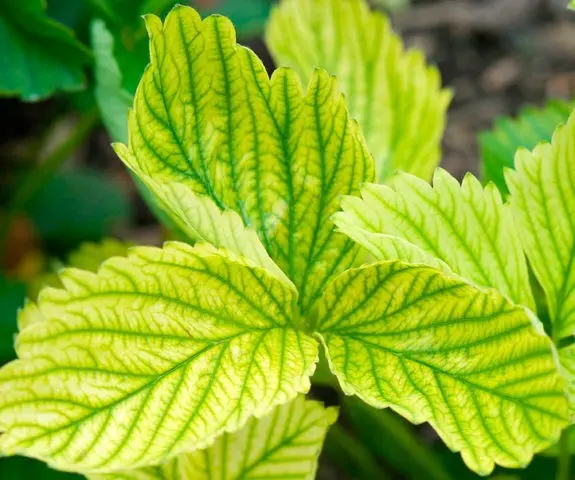
In chlorosis, the veins may remain green.
The yellowing of hydrangeas is due to iron deficiency in the plant’s body. The cause of the disease is either its lack in the soil, or its excessively high alkalinity. It does not allow hydrangeas to properly absorb this trace element.
Treatment of the disease: adding iron salts to the soil, acidifying the soil, changing the mode of care for the plant.
White rot
One of the most common fungal diseases of hydrangea. The fungus rapidly infects the leaves, stems and roots of the flower. Consuming important substances, it completely deprives the plant of nutrition, from which it can die. It mainly infects hydrangeas in greenhouses. Garden or indoor crops suffer from it less often.
Symptoms: a white coating similar to cotton wool and darkening hydrangea shoots rotting near the ground.
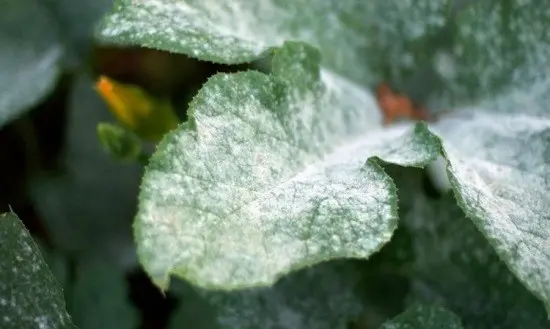
The fungus spreads very quickly and is able to completely cover the surface of the leaves.
Comprehensive treatment is necessary: the affected areas should be removed and burned, treating the sections with a solution of potassium permanganate. Partially damaged and neighboring healthy bushes should be sprayed with copper-containing preparations.
Mučnistaâ rosa
It mainly affects young hydrangeas that lack root nutrition. In some cases, the disease provokes excessive fertilization of the bush with nitrogen. Symptoms: numerous pale yellow-green spots.
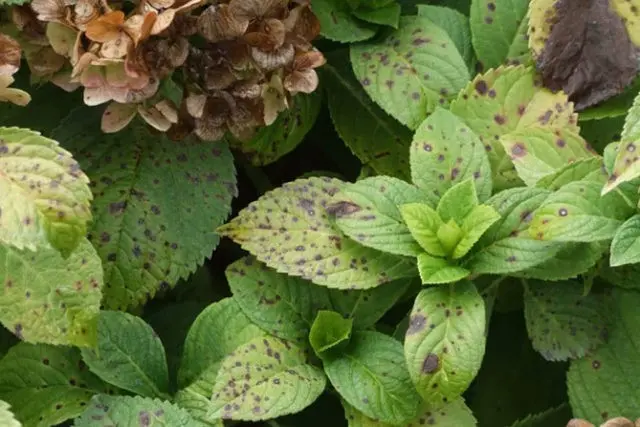
At a later stage, the disease is characterized by purple spots on the leaves.
This type of fungus affects exclusively hydrangea (each culture has its own powdery mildew pathogen), so it is safe for neighbors of other species.
Treatment of the disease consists in the destruction of damaged areas and the treatment of foliage with Fitosporin or Topaz.
septoriosis
A fungal disease that manifests itself at low temperatures and high humidity. Symptoms: spots up to 0,5 cm in diameter, light in the center and dark at the edges.
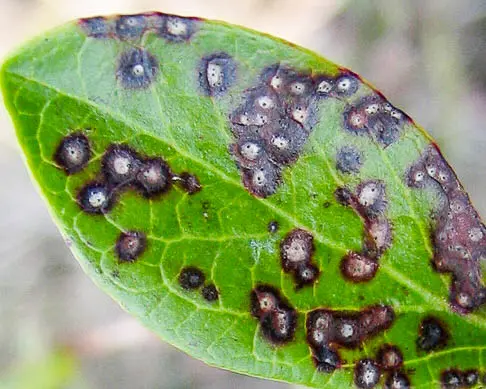
After the appearance of white spots in the center, they are covered with small holes, from which spores of the fungus are sown.
Treatment: removal of damaged areas, treatment of the cut with potassium permanganate, spraying with copper-containing preparations and special equipment, for example, Rodomite Gold.
ring spot
It is predominantly a disease of hydrangea paniculata. A viral disease, the spread of which does not depend on weather conditions or care. Symptoms: Spots appear in the form of rings on the hydrangea.

In the later stages, the spots darken and the leaves shrivel.
There is no cure for the disease, since effective drugs do not exist. With a high probability, the hydrangea will die, therefore, in order to avoid the spread of infection, the bush should be destroyed.
hydrangea cancer
Oncology is characteristic not only of animals, but also of plants. Symptoms of the disease: numerous brown spots, ulcers appear on the reverse side of the leaf under the spots.
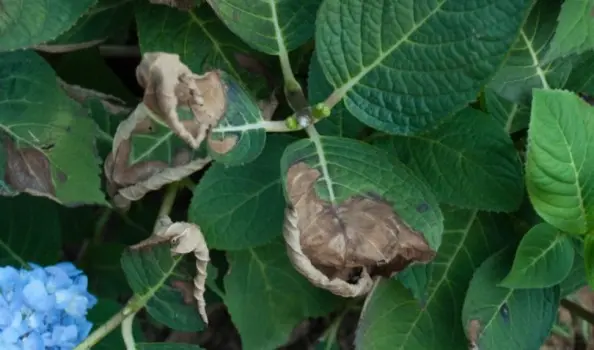
With the development of the disease, the spots merge into larger ones, and the leaves dry out.
Definitely, the causes of hydrangea cancer are unknown, it is believed that it is provoked by mechanical damage to the bush. Treatment consists in removing the affected areas. The disease is currently considered non-contagious.
No flowering
Hydrangea may not bloom for several reasons:
- erroneous pruning of last year’s shoots, on which buds form;
- freezing of buds;
- too much direct sunlight;
- irregular watering and fertilizing.
The solution to the problem is aimed at overcoming these factors: the use of diffused light, sheltering the plant for the winter, etc.
Diseases of room hydrangea
In general, room hydrangea leaf diseases repeat garden ones. The only difference is that outdoor plants are more susceptible to fungal diseases, since the humidity in the garden will always be higher than at home.
Peronosporoz
Like all fungi, this disease occurs at high humidity, but requires elevated temperatures for normal development. Symptoms are oily spots on the stems and leaves, eventually changing color to grayish-brown.
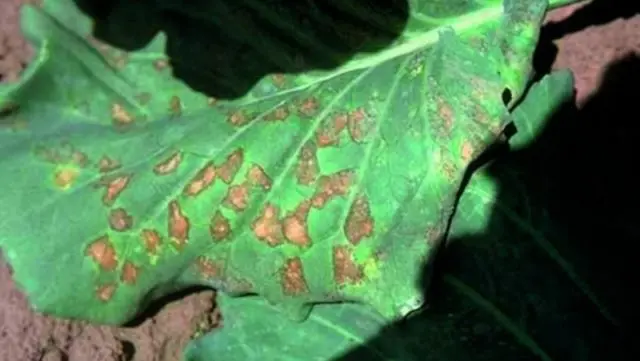
Leaves affected by downy mildew lose their shape and curl
The treatment of the disease consists in removing the damaged areas (up to the entire stems) and spraying the plant with a 1% solution of Bordeaux mixture or drugs similar in action (Kuproskat, Optimo, Kumir, etc.)
Gray mold
Mostly this fungus attacks young leaves, in rare cases – shoots. The reason is excessive waterlogging of the room, too frequent and abundant watering, shading of the room, crowding of plants.

With high humidity, gray rot quickly spreads throughout the plant.
Treatment of the disease consists in the timely removal and destruction of the affected areas. After that, the flower should be sprayed with a solution of potassium permanganate. If the lesion has become global, the best option would be to completely destroy the plant so that the disease does not spread to neighboring ones. It is also recommended to spray bushes with a damage level of less than 30% with Fundazol.
Dry blackening of foliage
In some cases, when the hydrangea is sick, it will develop brown spots on the leaves. Gradually they cover the surface of the entire plant.
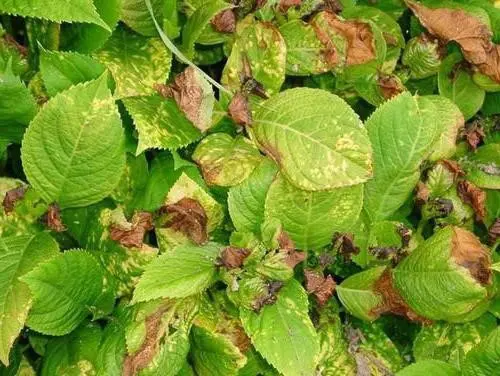
The middle stage of the disease partially affects all leaves
The reason is watering hydrangeas with hard water and sunburn. The treatment of the disease in this case is very simple – use settled water and place the flower in the shade.
Wet blackening of foliage
In the event of a sharp change in temperature or an increase in humidity, droplets of water appear on the leaves, after which they begin to turn black.
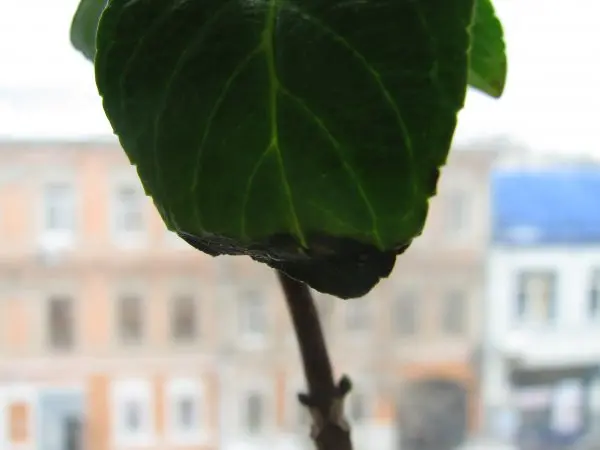
The plant loses its shape, its branches droop
You can cope with the disease very simply – by placing the flower in conditions (temperature and humidity) that are appropriate for growing. At the same time, it is recommended to reduce the dose of irrigation for the next month by half.
Phallostictose spotting
The manifestation of the disease is observed in the form of merging dark red spots with a brightening center. Subsequently, the spots expand, and a purple border stands out along their edges. Then spores appear in the form of small black dots.
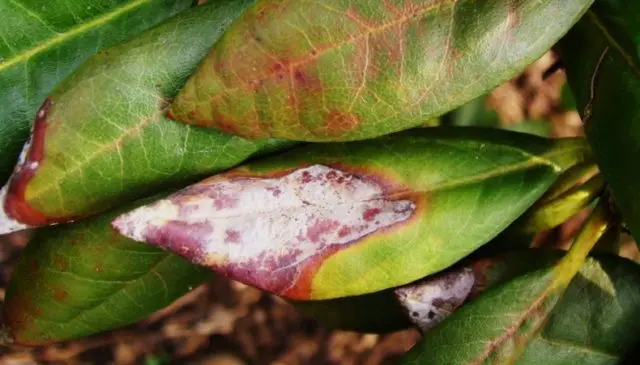
Phyllostic blotch at a late stage of the disease irrevocably destroys the leaves
Treatment is standard for fungal diseases – removal of damaged areas and preventive treatment of foliage with copper sulphate 1%.
Ascochitous spotting
The symptomatology is the appearance of rounded spots, which, growing, acquire an irregular shape. Sometimes the spots are surrounded by a dark brown or crimson border. In the dead tissue in their centers, the fruiting bodies of fungi are formed, which hibernate in this form.
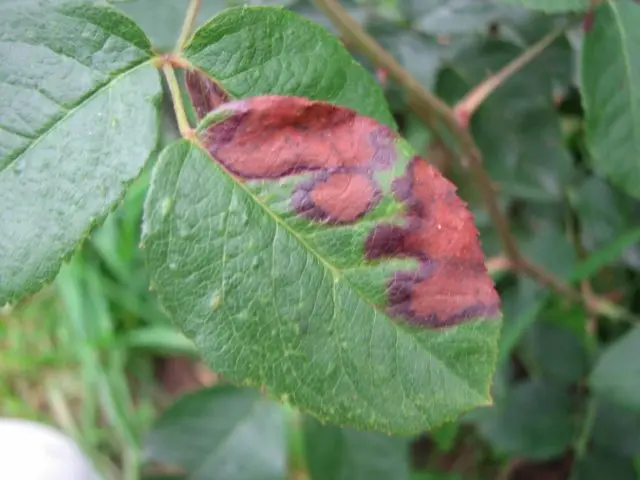
Ascochyta blotch mainly affects the leaves in the upper part of the plant.
Treatment consists in removing the affected areas with their obligatory destruction. It is followed by prophylactic treatment with copper-containing preparations.
Rust
Fungal infection that occurs with excess water and nitrogen fertilizers. Symptoms: small yellow or brownish-brown spots, later turning into brown growths. Rusty-colored spores spill out of the growths.
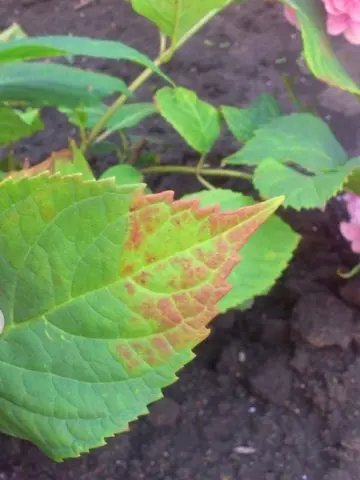
Most often, rust is localized on the edges of the foliage.
Treatment consists in removing damaged leaves and treating the plant with copper chloride at a concentration of 40 g per 10 liters of water. You can use Topaz.
Hydrangea pests and their control
Most often, the plant is attacked by various types of insects. But the list of pests is not limited to arthropods alone. A weakened hydrangea can suffer from protozoa and slugs. Below are the most common pests.
aphid
It is a small parasitic insect that feeds on plant sap. The aphid colony is always clearly visible on the leaves. Often a sign of its presence are ants eating honeydew (droplets of sweet liquid) allocated to it.
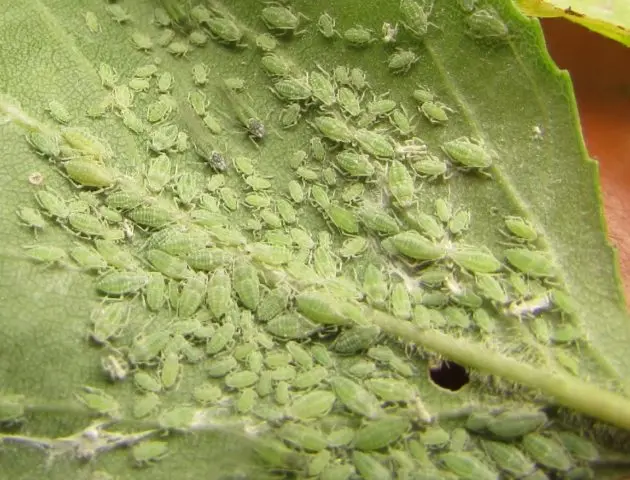
In large numbers, aphids can pose a serious threat to any crop.
Treatment consists in treating the plant with insecticides: Fitoverm, Streda, Spark. In the case of small colonies, you can get by with folk remedies – soapy water or simply washing insects off the leaves with water from a pressure hose.
There is also a biological way to fight with the help of ladybugs, natural enemies of aphids. To attract them, you can plant marigolds near the hydrangea.
spider mite
Small arthropods that also feed on plant sap. They appear mainly in the hot season or during a drought. Symptoms: the presence of cobwebs on the leaves. With a large number of colonies, they are visible to the naked eye from the underside of the leaves.
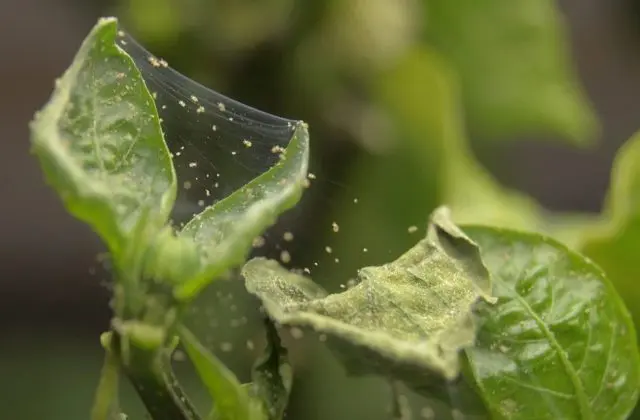
Leaves affected by spider mites may curl
The treatment is the same as in the case of aphids. If the colony is small, treatment with soapy water is sufficient. If it grows to a large size, chemical treatment is necessary. Conventional insecticides may not be enough, therefore, special means against ticks are used – acaricides. These can be: Akrin, Akrofit, Apollo, Vermitek.
Shellfish
Garden snails and slugs can be a danger to hydrangeas, especially young plants. In adults, they eat fresh leaves, growth zones and newly opened buds. Mollusks acquire maximum activity during periods of high humidity.

The presence of slugs can be detected by characteristic leaf damage.
Another sign of their activity is footprints on the paths and stems of plants.
Mostly mollusks are harvested by hand, destroying their resting places and laying eggs. Beer traps can be effective.
Sometimes they are used to exterminate slugs of their natural enemies – birds or toads. Treatment of hydrangeas from these pests using chemicals (for example, Molluscocide) has certain risks, since all products of this kind are toxic.
Nematode
This pest is a protozoan that affects the roots of a plant. From there, the worm enters the trunks. The danger is represented by its waste products, which are poison for plants. External manifestations of the nematode are red galls on the leaves and characteristic root lesions.
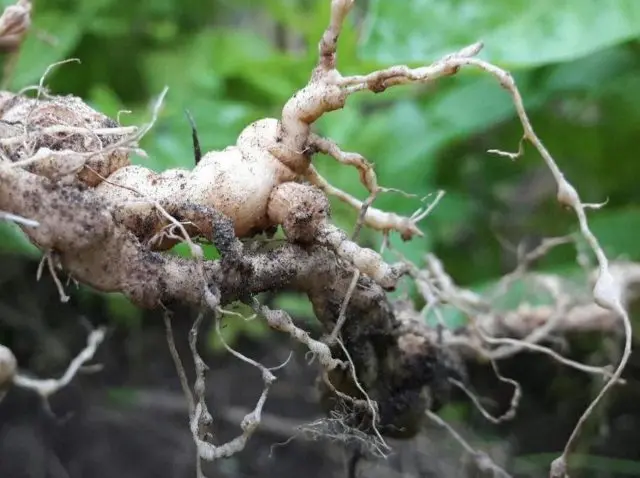
Tuberous lesions of the root system are characteristic of nematodes
Pest control is preventive in nature. To do this, sugar is added to the soil, which is food for other types of microscopic worms that parasitize nematodes. Preparations Aktofit and Fitoverm should be applied a few days before planting the plants in the ground.
May beetles
The larvae of these insects feed on plant roots. Among the victims of these pests may be hydrangea. Damage to the root system leads to a deterioration in the nutrition of the plant, it can wither or even die completely.
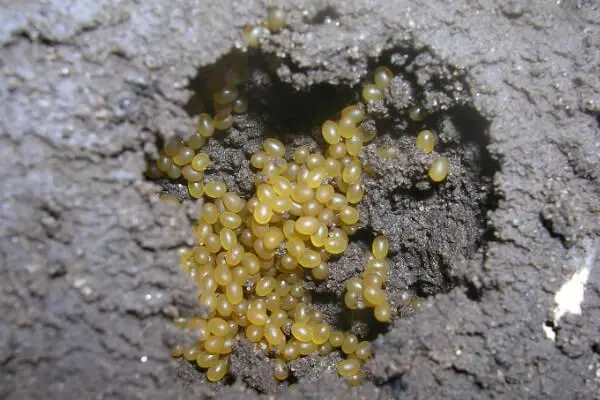
If clutches of the May beetle are found, they should be destroyed immediately.
Preventive treatment from larvae consists in watering hydrangeas with infusion or decoction of onion peel. Spraying the bushes with a solution of ammonia (20 ml per 10 liters of water) will also be effective.
Medvedka
The omnivorous nature of the bear is well known. This insect, in the absence of natural food sources, can damage the roots of ornamental plants, including hydrangeas.
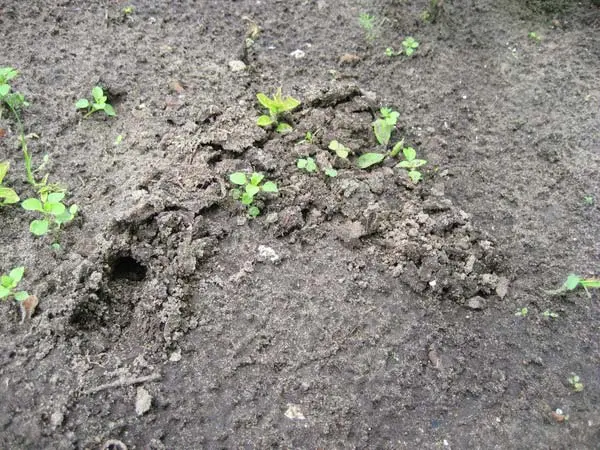
A sign of the appearance of a bear will be numerous holes of small diameter in the area
The fight against the bear is complex. The use of traps, poisonous baits, and preventive treatment of hydrangeas with insecticides should be combined.
night scoops
The larvae of these butterflies are capable of causing irreparable damage to the plant in a relatively short time, since the speed of eating leaves is very high. Sometimes the devastating effect of caterpillars can destroy an entire bush in less than one day. Therefore, it is necessary to regularly inspect hydrangea leaves to detect this pest.
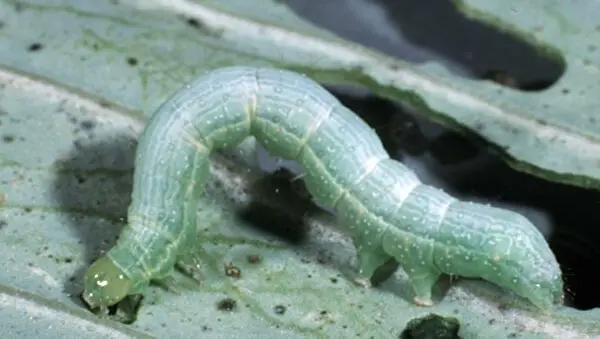
Scoop caterpillars eat large holes in the leaves
To combat cutworms, contact insecticides are used, which are sprayed on the leaves monthly, starting in May. Birds attracted to the site will be an effective way to influence the pest.
Disease and Pest Prevention
Practice shows that preventive measures carried out at the required frequency require much less effort than treating a plant in case of infection.
The main measures for the prevention of hydrangea include:
- maintaining the correct acidity and mineral composition of the soil;
- compliance with the cut-off mode: hydrangeas need diffused light and partial shade;
- careful selection of seedlings for planting;
- regular soil mulching;
- disinfection of garden tools after each and the destruction of all cut shoots or leaves;
- treatment of hydrangeas in early spring with antifungal drugs.
Hydrangea spring treatment consists of antifungal copper-containing drugs, for example, a 1% copper sulfate solution. In the summer, they usually do not take preventive actions, but in the fall, hydrangeas can be treated for diseases and pests with a solution of 3% Bordeaux mixture.
Conclusion
Hydrangea diseases, with proper care of the plant and appropriate weather, almost never appear. Both bush and standard forms have strong immunity and, with the right approach to agricultural technology, successfully fight against any pathogens. In those rare cases when the disease still attacks the hydrangea, its treatment does not present any special problems and comes down mainly to adjusting the conditions of the plant and processing it with appropriate drugs.









